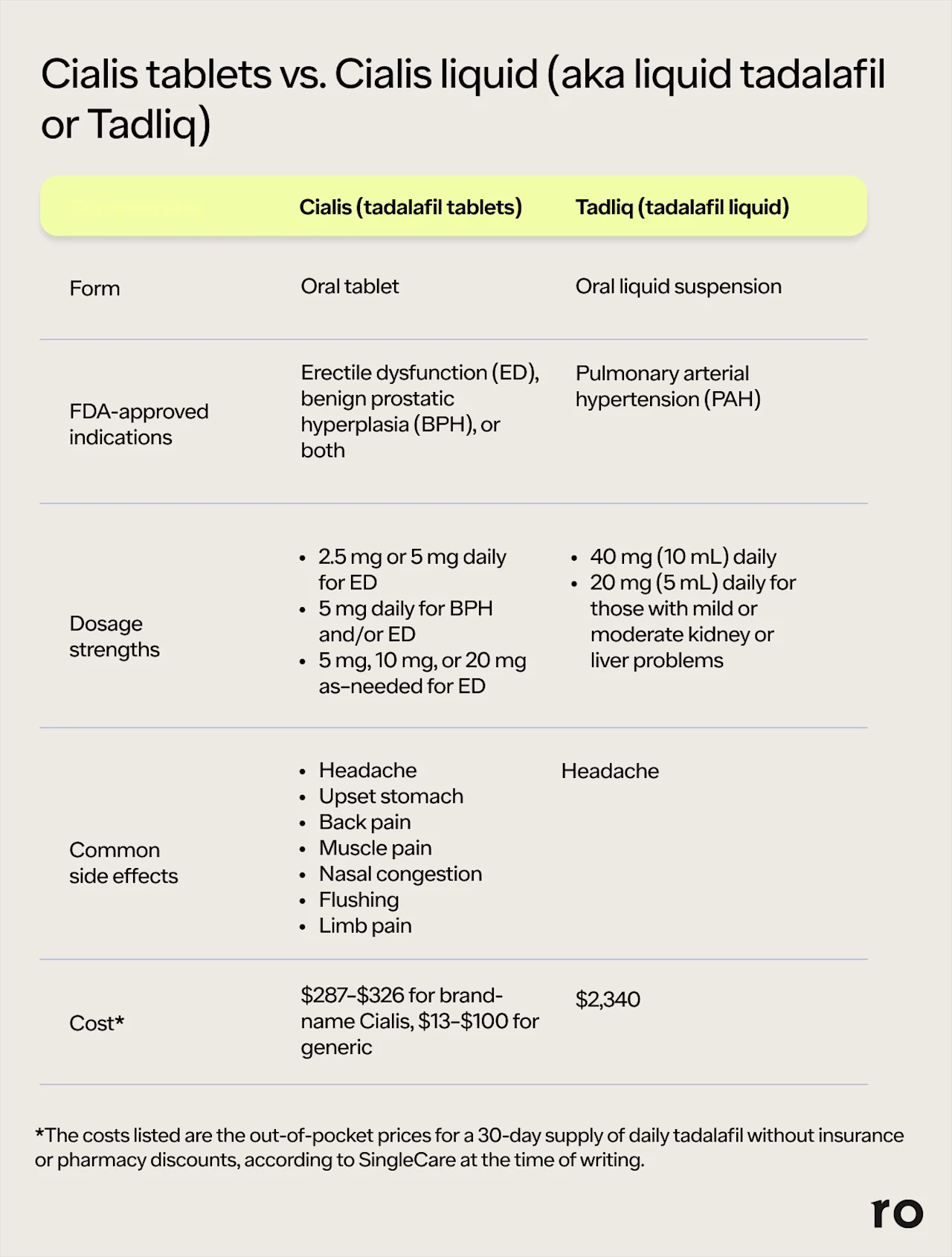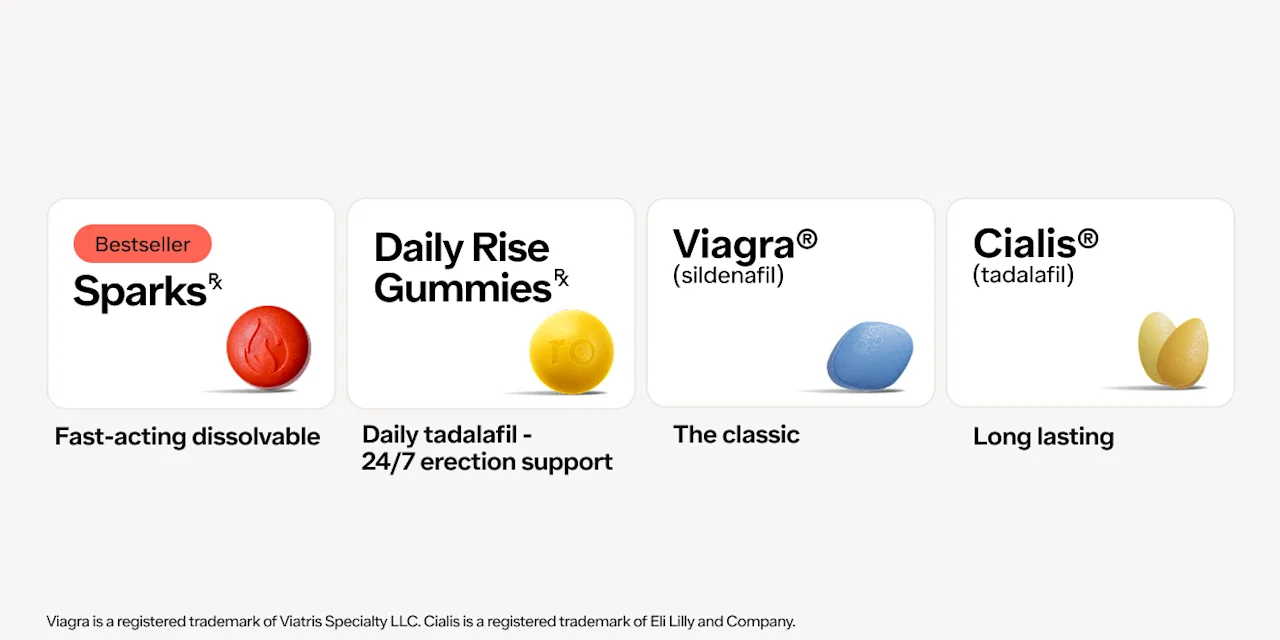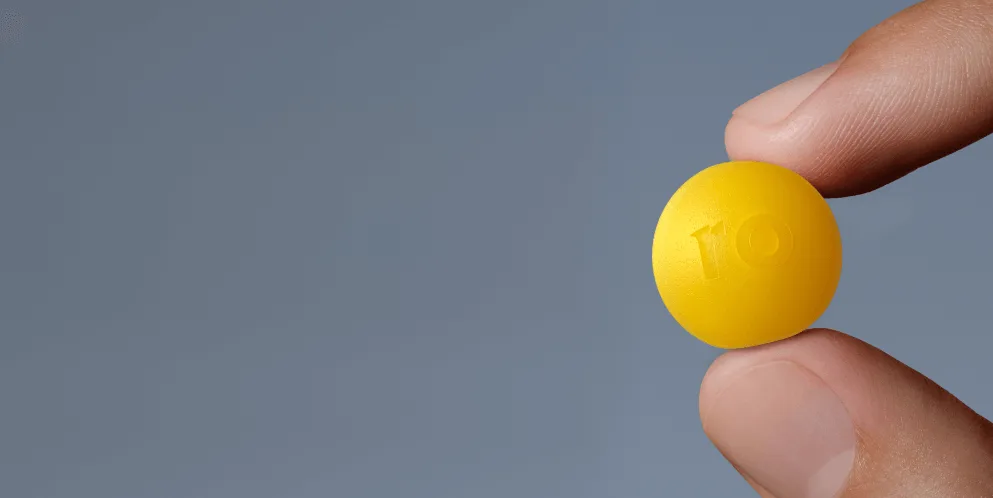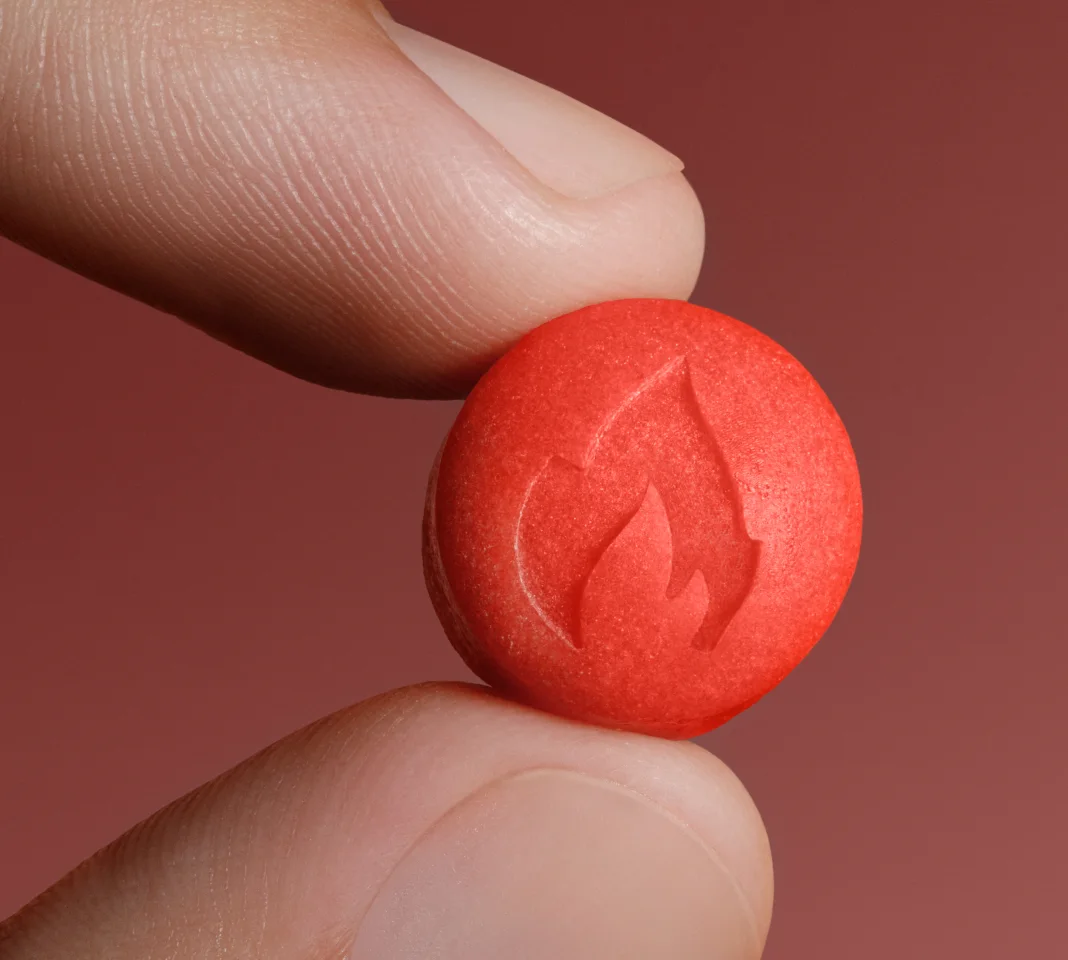Key takeaways
Cialis doesn’t typically come in liquid form for erectile dysfunction (ED) in the United States. Only the oral tablet form of Cialis (and its generic, tadalafil) is approved for ED.
The active ingredient in Cialis comes in a liquid form that’s available under the brand name Tadliq. It’s approved for pulmonary arterial hypertension, a type of high blood pressure in the lungs.
Some compounding pharmacies may offer liquid tadalafil for ED. These versions are not FDA-approved and may carry risks related to quality, dosage accuracy, and contamination.
If you have difficulty swallowing pills, talk to your healthcare provider about safe alternatives. Avoid buying so-called “liquid Cialis” from unregulated online sources.
Here's what we'll cover
Here's what we'll cover
Here's what we'll cover
Key takeaways
Cialis doesn’t typically come in liquid form for erectile dysfunction (ED) in the United States. Only the oral tablet form of Cialis (and its generic, tadalafil) is approved for ED.
The active ingredient in Cialis comes in a liquid form that’s available under the brand name Tadliq. It’s approved for pulmonary arterial hypertension, a type of high blood pressure in the lungs.
Some compounding pharmacies may offer liquid tadalafil for ED. These versions are not FDA-approved and may carry risks related to quality, dosage accuracy, and contamination.
If you have difficulty swallowing pills, talk to your healthcare provider about safe alternatives. Avoid buying so-called “liquid Cialis” from unregulated online sources.
If you’re looking into erectile dysfunction (ED) treatments, you’ve probably heard of popular options like Viagra (sildenafil) and Cialis (tadalafil). Many individuals prefer Cialis over Viagra, mainly because it lasts longer and, thus, allows for more spontaneity.
But not everyone wants to pop a pill before sex — or at any time, for that matter. So, is liquid Cialis an option? Technically, no. Cialis is only available in tablet form. Tadalafil (the active ingredient in Cialis) is available as a liquid under the brand name Tadliq. But it’s not an approved treatment for ED.
Keep reading to learn more about liquid Cialis, how it compares to liquid tadalafil, and more.
What is liquid Cialis (tadalafil)?
Liquid Cialis doesn’t exist, but liquid tadalafil does. It is known as Tadliq and approved to treat pulmonary arterial hypertension — not ED. Confused? Let us explain.
Cialis is a brand-name tablet containing tadalafil as an active ingredient. It’s prescribed to treat both erectile dysfunction and benign prostatic hyperplasia (BPH), or an enlarged prostate. The tablet, Cialis, and its generic (tadalafil) are the only forms of tadalafil currently approved by the US Food and Drug Administration (FDA) to treat ED.
In 2022, the FDA approved a liquid form of tadalafil under the brand name Tadliq as a treatment for pulmonary arterial hypertension (PAH), a type of high blood pressure in the lungs.
The liquid form of tadalafil is not approved to treat ED. So, as of this writing, there is no liquid Cialis.
Both Cialis and liquid tadalafil are PDE5 inhibitors. These medications work by relaxing the blood vessels and surrounding tissues, thereby increasing blood flow. In the context of ED, this increase in blood flow to the penis enables you to get and maintain an erection once you’re already feeling aroused. (No PDE5 inhibitor, including Cialis, makes you horny. You have to be aroused for their effects to kick in.)
Is liquid Cialis available?
No, liquid Cialis isn’t on the market.
Currently, Cialis for ED is only available in tablet form. In 2022, the FDA approved Tadliq, a liquid form of tadalafil (the active ingredient in Cialis). At the moment, it is only approved to treat pulmonary arterial hypertension (PAH) — not ED.
In the meantime, most people tolerate the traditional Cialis tablets just fine. And it’s possible for a healthcare provider to prescribe Tadliq off-label ED. However, if you have trouble swallowing pills, speak with your healthcare provider about the option of getting liquid tadalafil from a compounding pharmacy.
Compounding means taking one form of a medication and changing it into another form, based on a person’s individual needs. With a prescription from your healthcare provider, a compounding pharmacy can make Cialis tablets into a liquid form.
Compounded medications are not approved by the FDA and do not undergo the same testing as prescription medications. But tadalafil, the active ingredient in Cialis tablets and so-called liquid Cialis (i.e. compounded liquid tadalafil), has been individually FDA-approved for ED.
A quick online search may show plenty of places advertising “liquid Cialis,” but these are not reputable pharmacies and shouldn’t be used. PDE5 inhibitors like tadalafil are some of the most counterfeited drugs worldwide, so it’s important to only use licensed pharmacies. If you can’t take Cialis in tablet form, ask your healthcare provider about potentially — and safely! — compounding it into a liquid.
Cialis tablets vs. Cialis liquid (aka liquid tadalafil or Tadliq)

How long does liquid Cialis last?
Tadalafil lasts up to 36 hours, whether it’s a tablet (such as brand-name Cialis) or liquid (such as brand-name Tadliq or compounded liquid tadalafil). But since these forms are typically used for different conditions, the dose may not be the same for everyone. So be sure to follow your prescriber’s instructions.
Liquid tadalafil (Tadliq) has a half-life of 15 hours in healthy people. (Half-life refers to how long it takes for the concentration of the drug to decrease by half in your body.)
Among certain people with PAH, the half-life of liquid tadalafil is 35 hours. For example, if you take 40 mg of liquid tadalafil, it’s estimated that 15–35 hours later, 20 mg remains. But exactly how long a drug lasts can vary from person to person. It depends on age, kidney or liver function, health conditions, other medications, and other factors.
If you take liquid tadalafil daily, try to take it around the same time each day to ensure a steady level of the medication in your system.
Liquid tadalafil uses
Liquid tadalafil, which goes by the brand name Tadliq, is only FDA-approved to treat one health condition: pulmonary arterial hypertension (PAH).
Currently, liquid tadalafil is not approved to treat ED.
Cialis tablet, on the other hand, is FDA-approved to treat erectile dysfunction (ED), benign prostatic hyperplasia (BPH) or enlarged prostate, and ED in combination with BPH.
Compounded versions of tadalafil, whether liquid or pill form, may be prescribed to meet the needs of an individual patient. While legal, compounded drugs do not undergo FDA approval and, thus, do not have a specified or approved use.
Tadalafil liquid dosage
The recommended dosage for liquid tadalafil (Tadliq) is 40 mg (10 mL) daily.
Tadliq comes in a bottle and includes a measuring cup you’ll use to measure out your dose. Shake the bottle well for 30 seconds before you measure your dose. The liquid solution has a peppermint flavor and can be taken with or without food.
If you have certain health conditions, your healthcare provider may prescribe a different dosage. The dosage for people with mild or moderate kidney or liver impairment is 20 mg (5 mL) daily.
People with severe kidney or liver issues should not take liquid tadalafil. Your healthcare provider may also prescribe a different dosage of liquid tadalafil if you take ritonavir.
There is no standard dosing recommendation for liquid tadalafil for ED. That’s because it’s either being prescribed off-label as Tadliq or a compounded medication. If your healthcare provider prescribes liquid tadalafil for ED, follow their dosing guidance.
The tablet form of tadalafil (Cialis), which is FDA-approved to treat BPH, ED, or both, comes in four dosage strengths: 2.5 mg, 5 mg, 10 mg, and 20 mg.
Similar to liquid tadalafil, Cialis (or its generic version, tadalafil) tablets can be taken with or without food. The recommended tadalafil dosage can vary depending on what you’re taking it for, other medications you’re taking, and other health conditions you have. For example:
When taken on demand for ED: The recommended dosage of Cialis is 10 mg at least 30 minutes before you plan on having sex. Once taken, the effects of Cialis can last for up to 36 hours. Depending on your response to the drug and tolerance for side effects, your healthcare provider may increase your dosage up to 20 mg or decrease it to 5 mg.
When taken daily for ED: The recommended dosage of Cialis is 2.5 mg, taken daily regardless of when you plan on having sex. If needed, your healthcare provider may increase your dosage to 5 mg daily.
When taken to treat BPH or ED and BPH at the same time: The recommended dosage of Cialis is 5 mg daily at roughly the same time every day.
If you have kidney or liver problems or take certain medications (e.g. ketoconazole or ritonavir), your healthcare provider may adjust your dosage of tadalafil.
Is there a tadalafil 30mg liquid dosage?
No. The maximum dosage of liquid tadalafil is 40 mg daily, and the maximum dosage of oral tadalafil for ED is 20 mg as-needed or 5 mg daily. Neither liquid nor oral tadalafil comes in a 30mg dosage strength. However, a healthcare provider may prescribe 30mg of liquid tadalafil for a particular patient depending on their specific needs.
How much Cialis should I take for ED?
When taking Cialis for ED, you should always take the medication exactly as directed by your healthcare provider.
The typical dosages of Cialis for ED include:
2.5 mg or 5 mg for daily use
5 mg, 10 mg, or 20 mg for as-needed use
Your healthcare provider will prescribe a strength for you based on your response to the medication and whether you have any health conditions or take certain medications that could increase your risk of experiencing side effects on Cialis.
Liquid Cialis side effects
The most common side effect of liquid tadalafil (Tadliq) is headache. In clinical trials, headache affected up to 42% of people taking the drug. Other common side effects include:
Myalgia (muscle pain)
Nasopharyngitis (cold-like symptoms)
Facial flushing
Respiratory tract infection
Limb pain
Nausea
Back pain
Upset stomach or indigestion
Nasal congestion
Liquid tadalafil can also cause serious side effects, including:
Hypotension (low blood pressure)
Vision changes or loss
Hearing loss
Priapism (a prolonged, possibly painful erection lasting more than 4 hours)
Some people may be more likely to experience serious side effects on liquid tadalafil, including those with mild or moderate kidney or liver issues. People with severe kidney or liver issues should not take liquid tadalafil. People taking ritonavir may need their healthcare provider to adjust their dosage of tadalafil.
And because Cialis can lower blood pressure, there may be an increased risk of low blood pressure when you take it with alcohol, medications that treat high blood pressure, or alpha-blockers such as doxazosin, alfuzosin, or tamsulosin.
Liquid tadalafil should not be taken at the same time as certain medications, including:
Other PDE5 inhibitors, such as Cialis or Viagra
Nitrates
CYP3A inhibitors, such as ketoconazole and itraconazole
CYP3A inducers, such as rifampin
Liquid Cialis precautions
If your healthcare provider prescribes liquid Cialis (either as off-label Tadliq or compounded liquid tadalafil), it’s very important that you take it as directed to avoid serious side effects. Depending on how it’s prescribed (i.e. for what use), you may fill your prescription through a compounding pharmacy.
Here are a few steps to take to ensure you’re using liquid Cialis as safely as possible:
Meet with a licensed healthcare professional first. Liquid tadalafil requires a prescription, just like Cialis tablets. You’ll need to meet with a licensed healthcare provider to get it. During your appointment, your healthcare provider should ask you questions about your ED symptoms, current medications you’re taking, and underlying health conditions. Answer honestly and completely so they can ensure liquid tadalafil will be safe for you to take — or recommend another ED treatment if needed.
Never buy “over-the-counter” Cialis. Cialis and tadalafil are both prescription medications. OTC Cialis does not exist. If you find a site advertising it, know it’s probably a scam. ED medications are frequently counterfeited, and when they are, they often contain unlisted ingredients that could be dangerous. The makers of these “drugs” also tend to play fast and loose with the amounts of the active ingredient. So what you get may not be enough tadalafil to be effective — or too much to be dangerous.
Use a trusted pharmacy. When filling your prescription, check that the pharmacy is up to snuff. Per the FDA, a safe online pharmacy always requires a prescription from a licensed healthcare provider, has a US address and telephone number, is licensed with a state board of pharmacy, and has a licensed pharmacist on staff. (Ro meets all of these qualifications, by the way.)
Take liquid Cialis as directed. Your healthcare provider will give you instructions about how to take liquid Cialis. Follow them. The medication should come with a packaging insert that includes additional directions. Review this before you use liquid Cialis for the first time.
Speak up if you have questions. Wondering “how many drops of liquid tadalafil should I take?” If you have any questions about using liquid Cialis safely, reach out to your healthcare provider or pharmacist. They are there to help you receive safe treatment.
Alternative treatments for ED
Liquid tadalafil is not FDA-approved for ED. However, there are several FDA-approved options for treating ED as well as other proven methods to improve your erections without medication.
Prescription medications for ED. Cialis is not the only Rx drug that can be used to treat ED. Other effective ED pills include Viagra (sildenafil), vardenafil, and Stendra (avanafil). You can also find certain PDE5 inhibitors in other formulations, such as gummies and lozenges like Ro Sparks and Daily Rise Gummies.
Penis pumps and implants. With a penis pump, a plastic tube is placed over the penis, and you use a pump to create a vacuum and draw blood into the blood vessels of the penis to harden it. A plastic ring is then placed at the base of the penis to keep the blood there during sexual activity. Depending on the severity of your ED, a surgical implant can also be effective.
Making healthy lifestyle changes. Smoking, obesity, and a sedentary lifestyle all can increase the risk of ED. Losing weight, increasing physical activity, and improving your diet have all been shown to relieve symptoms of ED.
Taking care of your mental health. If factors such as depression or anxiety are contributing to your ED, therapy or prescription treatments can be beneficial. Sometimes, other medications you may be taking have ED as a side effect. Stopping or decreasing the dose of that medication (under your provider’s guidance and supervision) may improve ED symptoms.
If you’re experiencing ED, consult a healthcare provider. They can help determine the cause of your ED and develop the best treatment plan for you.
Bottom line
Liquid tadalafil isn’t FDA-approved for erectile dysfunction, but that doesn’t mean it’s completely off the table. While the only FDA-approved liquid tadalafil (Tadliq) is for a different condition, compounding pharmacies may be able to make a liquid version for ED with a prescription. Still, there are a few important things to keep in mind.
There’s no liquid Cialis for ED. Cialis and its generic version, tadalafil, only come as oral tablets. The only FDA-approved liquid tadalafil (Tadliq) is approved for pulmonary arterial hypertension, not erectile dysfunction.
Compounded liquid Cialis may be an option. If you can’t swallow pills, a compounding pharmacy may be able to turn Cialis into a liquid form. However, this version won’t be FDA-approved and probably won’t be covered by insurance.
Be wary of online sellers advertising OTC Cialis or OTC liquid Cialis. Anything labeled “Cialis” that’s sold without a prescription is likely counterfeit and potentially dangerous. Stick to trusted pharmacies that require a prescription from a licensed healthcare provider.
Talk to your provider. If you’re interested in a liquid version of Cialis or another ED treatment, your healthcare provider can help you explore safe and effective options tailored to your needs, from other ED pills to lifestyle changes.
Frequently asked questions (FAQs)
Is liquid Cialis better?
Whether liquid tadalafil is “better” for you than Cialis or tadalafil tablets depends on several factors, including your individual needs and the reason you’re taking the drug. Liquid tadalafil contains the same active ingredient as tadalafil tablets, which are sold as brand-name Cialis and generic tadalafil. Liquid tadalafil is approved for pulmonary arterial hypertension (PAH); oral tadalafil is approved for erectile dysfunction (ED) and benign prostate hyperplasia (BPH).
How long does liquid Cialis take to kick in?
Liquid tadalafil (Tadliq) typically reaches a peak concentration in your bloodstream within four hours on average. However, it may take as little as two or as long as eight. After five days of taking liquid tadalafil for PAH, the drug should reach a steady state in your system.
Is tadalafil available in liquid form?
Yes, tadalafil is available in a liquid form under the brand name Tadliq. Liquid tadalafil is only FDA-approved to treat pulmonary arterial hypertension (PAH). Tadalafil tablets, on the other hand, is only FDA-approved to treat ED or BPH.
DISCLAIMER
If you have any medical questions or concerns, please talk to your healthcare provider. The articles on Health Guide are underpinned by peer-reviewed research and information drawn from medical societies and governmental agencies. However, they are not a substitute for professional medical advice, diagnosis, or treatment.
Cialis Important Safety Information: Read more about serious warnings and safety info.
Viagra Important Safety Information: Read more about serious warnings and safety info.
Burnett, A. L., Nehra, A., Breau, R. H., et al. (2018). Erectile dysfunction: AUA guideline. Journal of Urology, 200(3), 633–641. doi: 10.1016/j.juro.2018.05.004. Retrieved from https://www.auajournals.org/doi/10.1016/j.juro.2018.05.004
Chiang, J., Yafi, F. A., Dorsey, P. J., Jr, et al. (2017). The dangers of sexual enhancement supplements and counterfeit drugs to "treat" erectile dysfunction. Translational Andrology and Urology, 6(1), 12–19. doi: 10.21037/tau.2016.10.04. Retrieved from https://pmc.ncbi.nlm.nih.gov/articles/PMC5313300/
CMP Pharma. (2025). Home - Tadliq (Tadalafil) Oral Suspension. Retrieved from https://tadliq.com/
DailyMed. (2025). Tadalafil tablet, coated. Retrieved from https://dailymed.nlm.nih.gov/dailymed/drugInfo.cfm?setid=abcb2cda-9b3f-45f6-ad5f-c2370b0dd114
Dhaliwal, A. & Gupta, M. (2023). PDE5 inhibitors. StatPearls. Retrieved from https://www.ncbi.nlm.nih.gov/books/NBK549843/
Gong, B., Ma, M., Xie, W., et al. (2017). Direct comparison of tadalafil with sildenafil for the treatment of erectile dysfunction: a systematic review and meta-analysis. International Urology and Nephrology, 49(10), 1731–1740. doi: 10.1007/s11255-017-1644-5. Retrieved from https://pmc.ncbi.nlm.nih.gov/articles/PMC5603624/
Krzastek, S. C., Bopp, J., Smith, R. P., et al. (2019). Recent advances in the understanding and management of erectile dysfunction. F1000Research, 8, F1000 Faculty Rev-102. doi: 10.12688/f1000research.16576.1. Retrieved from https://pmc.ncbi.nlm.nih.gov/articles/PMC6348436/
Sansone, A., Cuzin, B., & Jannini, E. A. (2021). Facing Counterfeit Medications in Sexual Medicine. A Systematic Scoping Review on Social Strategies and Technological Solutions. Sexual Medicine, 9(6), 100437. doi: 10.1016/j.esxm.2021.100437. Retrieved from https://pmc.ncbi.nlm.nih.gov/articles/PMC8766274/
SingleCare-a. (n.d.). Cialis Coupons & Prices. Retrieved from https://www.singlecare.com/prescription/cialis
SingleCare-b. (n.d.). Tadalafil Coupons & Prices. Retrieved from https://www.singlecare.com/prescription/tadalafil
SingleCare-c. (n.d.). Tadliq Coupons & Prices. Retrieved from https://www.singlecare.com/prescription/tadliq
Sooriyamoorthy, T. & Leslie, S. W. (2024). Erectile dysfunction. StatPearls. Retrieved from https://www.ncbi.nlm.nih.gov/books/NBK562253/
U.S. Food and Drug Administration (FDA). (2024). Compounding and the FDA: Questions and Answers. Retrieved from https://www.fda.gov/drugs/human-drug-compounding/compounding-and-fda-questions-and-answers.
U.S. Food & Drug Administration (FDA). (2022). Highlights of Prescribing Information: Tadliq (tadalafil) oral suspension. Retrieved from https://www.accessdata.fda.gov/drugsatfda_docs/label/2022/214522s000lbl.pdf
U.S. Food & Drug Administration (FDA). (2025). How to Buy Medicines Safely From an Online Pharmacy. Retrieved from https://www.fda.gov/consumers/consumer-updates/how-buy-medicines-safely-online-pharmacy
Watson, C. J., Whitledge, J. D., Siani, A. M., et al. (2021). Pharmaceutical Compounding: a History, Regulatory Overview, and Systematic Review of Compounding Errors. Journal of Medical Toxicology: Official Journal of the American College of Medical Toxicology, 17(2), 197–217. doi: 10.1007/s13181-020-00814-3. Retrieved from https://pmc.ncbi.nlm.nih.gov/articles/PMC7605468/













